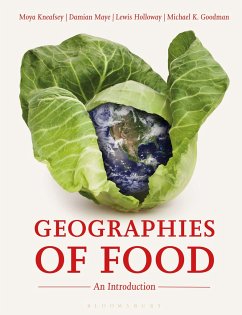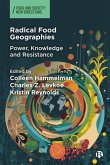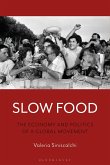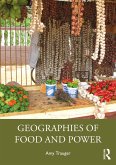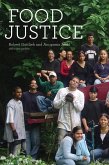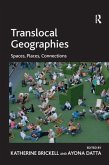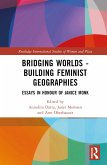Moya Kneafsey (UK University of Coventry), Damian Maye (UK University of Gloucestershire), Lewis Holloway (UK University of Hull)
Geographies of Food
An Introduction
Moya Kneafsey (UK University of Coventry), Damian Maye (UK University of Gloucestershire), Lewis Holloway (UK University of Hull)
Geographies of Food
An Introduction
- Broschiertes Buch
- Merkliste
- Auf die Merkliste
- Bewerten Bewerten
- Teilen
- Produkt teilen
- Produkterinnerung
- Produkterinnerung
Aimed at an international readership of undergraduate students of food, this comprehensive textbook uses a range of lively learning features and global case studies to provide an introduction to contemporary food geographies.
Andere Kunden interessierten sich auch für
![Radical Food Geographies Radical Food Geographies]() Radical Food Geographies137,99 €
Radical Food Geographies137,99 €![Digital Food Digital Food]() Dr Tania LewisDigital Food38,99 €
Dr Tania LewisDigital Food38,99 €![Slow Food Slow Food]() Valeria Siniscalchi (The School for Advanced Studies in the SocialSlow Food33,99 €
Valeria Siniscalchi (The School for Advanced Studies in the SocialSlow Food33,99 €![Geographies of Food and Power Geographies of Food and Power]() Amy Trauger (USA University of Georgia)Geographies of Food and Power66,99 €
Amy Trauger (USA University of Georgia)Geographies of Food and Power66,99 €![Food Justice Food Justice]() Robert Gottlieb (Henry R. Luce Professor of Urban and EnvironmentalFood Justice30,99 €
Robert Gottlieb (Henry R. Luce Professor of Urban and EnvironmentalFood Justice30,99 €![Translocal Geographies Translocal Geographies]() Ayona DattaTranslocal Geographies190,99 €
Ayona DattaTranslocal Geographies190,99 €![Bridging Worlds - Building Feminist Geographies Bridging Worlds - Building Feminist Geographies]() Bridging Worlds - Building Feminist Geographies168,99 €
Bridging Worlds - Building Feminist Geographies168,99 €-
-
-
Aimed at an international readership of undergraduate students of food, this comprehensive textbook uses a range of lively learning features and global case studies to provide an introduction to contemporary food geographies.
Hinweis: Dieser Artikel kann nur an eine deutsche Lieferadresse ausgeliefert werden.
Hinweis: Dieser Artikel kann nur an eine deutsche Lieferadresse ausgeliefert werden.
Produktdetails
- Produktdetails
- Verlag: Bloomsbury Publishing PLC
- Seitenzahl: 368
- Erscheinungstermin: 11. März 2021
- Englisch
- Abmessung: 243mm x 189mm x 19mm
- Gewicht: 710g
- ISBN-13: 9780857854582
- ISBN-10: 0857854585
- Artikelnr.: 40051612
- Herstellerkennzeichnung
- Libri GmbH
- Europaallee 1
- 36244 Bad Hersfeld
- gpsr@libri.de
- Verlag: Bloomsbury Publishing PLC
- Seitenzahl: 368
- Erscheinungstermin: 11. März 2021
- Englisch
- Abmessung: 243mm x 189mm x 19mm
- Gewicht: 710g
- ISBN-13: 9780857854582
- ISBN-10: 0857854585
- Artikelnr.: 40051612
- Herstellerkennzeichnung
- Libri GmbH
- Europaallee 1
- 36244 Bad Hersfeld
- gpsr@libri.de
Moya Kneafsey is Professor of Human Geography, Food, and Local Development at the Centre for Agroecology, Water, and Resilience at Coventry University, UK. Damian Maye is Professor of Agri-Food Studies at the Countryside and Community Research Institute, University of Gloucestershire, UK. Lewis Holloway is Professor of Human Geography at the University of Hull, UK. Michael K. Goodman is Professor of Geography at the University of Reading, UK.
Contents
List of figures
List of tables
List of boxes
List of activities
Insights
Preface
Acknowledgements
Dedication
Part 1: The Place of Food
Chapter 1: Introducing Geographies of Food
1.1 Introduction
1.2 What are food geographies?
1.2.1 Multiple food meanings
1.2.2 Food, place, space and scale
1.2.3 Mobilities and transformation: power and control
1.3 Geographical imaginations and food's geographies
1.4 Structure of the book
Chapter 2: Food and Place Identity
2.1 Introduction
2.2Making food and making places: landscapes, nations and labour
2.3 Moving food and making places: placing and displacing
2.3.1 Placing food: the case of 'terroir'
2.3.2 Displacing and placing food: migrant cuisines
2.3.3 Placing diets
2.4 Summary
2.5 Further reading
Part 2: Geographies of Food Production, Transformation and Consumption
Chapter 3: Geographies and Politics of Agricultural Production
3.1 Introduction
3.2 Geographies of food production: a global perspective
3.2.1 A global typology of primary food production systems
3.2.2 Overcoming the land-bias: the role of fisheries and marine management
3.2.3 Back to the land: global levels of food production
3.2.4 Geographical distribution of agricultural land
3.3 Agro-food commodity chains: product sector geographies
3.3.1 Cereals production
3.3.2 Fruit and vegetables
3.3.3 Meat and the changing chicken
3.3.4 Spatial concentration, newly agriculturalising economies and
relational assemblages
3.4 Producing food in the city: urban agriculture
3.5 Agricultural policy: political geographies of food production
3.5.1 The US Farm Bill
3.5.2 The Common Agricultural Policy (CAP)
3.5.3 Comparing the US Farm Bill and the CAP
3.6 Summary
3.7 Further reading
Chapter 4: What Happens to Food: Geographies of Mobility and Transformation
4.1 Introduction
4.2 Mobility and transformations: geographies and relationships
4.3 Transforming agriculture and food under capitalism: the agrarian
question
4.4 Liberalising food mobility: global trade policy and global food regimes
4.5 Government intervention, global food governance and free trade
4.5.1 From protectionism to free trade
4.5.2 Trading blocs and subsidy debates
4.5.3 Anti-politics and trade disputes
4.6 Global food trading: mobilising High Value Foods (HVFs)
4.7 'Big Food': transforming and industrialising food
4.8 Working in farming and food processing: the human cost
4.9 Wasting food in industrialised food systems
4.10 Summary
4.11 Further reading
Chapter 5: Eating Geographies: The Spaces and Cultures of Food Consumption
5.1 Introducing the geographies of eating
5.2 The shifting geographies of food consumption
5.3 Food's cultural geographies: eating space(s), places and connections
5.3.1 The spaces of food: the foodscapes of acquisition and access
5.3.2 The cultural spaces of food: the city, home and eating on the run
5.3.3 Eating the cosmopolitan city
5.3.4 Home cooking and eating
5.3.5 Eating bodies: making spatial and cultural connections through
identities
5.4 Eating geographical politics and ethics
5.4.1 Vegetarianism, veganism and low carbon diets
5.4.2 Food provenance: knowing your food
5.5 Summary: eating space, place and scale
5.6 Further reading
Part 3: Geographies of Food Crisis and Response
Chapter 6: Food Systems in Crisis? The New Food Insecurity
6.1 Introduction
6.2 The contours of the world food crisis
6.2.1Food prices and the 2007-08 price spike
6.3 The new food security debate
6.4 Explaining the 2007-2008 food price crisis: the new fundamentals
6.4.1Climate change and food insecurity
6.5 Financial speculation and the food crisis
6.5.1 Financial markets and agricultural derivatives
6.5.2 Food speculation, food prices and food security
6.6 Other critical interpretations of the food crisis and food insecurity
6.7 Summary
6.8 Further reading
Chapter 7: The Fight against Hunger and Malnutrition in the Majority World
7.1Introduction
7.2 The scale and geography of hunger and malnutrition in the Majority
World
7.2.1 Defining hunger and malnutrition
7.2.2. Where do hunger and malnutrition occur?
7.3 Causes of hunger and malnutrition in the Majority World
7.3.1 Poverty, Inequality and Conflict
7.3.2 International structural inequalities
7.4 The international response to hunger and malnutrition: from Green
Revolution to the Sustainable Development Goals
7.4.1 The Green Revolution
7.4.2 The World Food Conference and the World Food Summits
7.4.3 The Millennium Development Goals
7.4.4 The Sustainable Development Goals
7.5From corporate power to people power: the rise of food sovereignty
7.5Summary
7.6Further reading
Chapter 8: Food Insecurity Amidst Wealth
8.1 Introduction
8.2 Food insecurity in the 21st Century: scale, causes and consequences
8.2.1 What is food insecurity in rich countries?
8.2.2 The scale of food insecurity
8.2.3 The experience of food insecurity
8.2.4 Causes of food insecurity: Poverty, deprivation and food deserts
2.4.1 Poverty and deprivation
2.4.2 Food deserts
8.3 Solutions to food insecurity
8.3.1 Charitable food aid and the role of corporations
8.3.2 The right to food
8.3.3 Food sovereignty movements in wealthy countries
8.3.4 The movement for food justice
8.4. Summary
8.5 Further reading
Chapter 9 Reconnecting Consumers, Producers and Food
9.1 Introduction
9.2 AFNs: definition and geography
9.2.1 Defining AFNs
9.2.2Alternative food geography: reclaiming space and place
9.3 'First Generation' AFNs: locality foods, local food networks and fair
trade
9.3.1 Commodity circuits and geographical knowledges: the case of locality
foods
9.3.2 Local food networks: relations-of-proximity
9.3.3 Farmers' markets: purpose and benefits
9.3.4 Social embeddedness, geographies of regard and an ethic of care in
AFNs
9.3.5 The 'local trap' and further critiques of AFNs
9.4 Fair Trade networks: The moral economy of getting to know your coffee
farmer
9.4.1Fair Trade: connecting places and development through alternative
markets
9.4.2Into the mainstream and into the (fairer) future
9.5 'Second generation' AFNs and sustainability transitions
9.5.1 The Local Food programme in England
9.5.2 Food hubs and solidarity purchasing groups
9.5.3 Food security, transition theory and grassroots social innovations
9.5.4 Civic food networks
9.6 Summary
9.7 Further reading
Part 4: Geographies of Possible Food Futures
Chapter 10: Future Scenarios for Sustainable Food and Farming
10.1 Introduction
10.2 Towards sustainable food
10.3 Beyond productivist agriculture and 'big food': competing emergent
paradigms and 'food wars'
10.4 Technocentric approaches: sustainability through science?
10.5 Ecocentric approaches: sustainability through agroecology?
10.6 Sustainable diets and a decentralised food politics
10.6.1 Towards reflexive food governance?
10.6.2 Digital foodscapes and food citizenship
10.7 Summary
10.8 Further reading
Chapter 11: Conclusions
11.1 Introduction
11.2 Aftertaste - key themes revisited
11.2.1 Multiple food geographies
11.2.2 The co-production of food, place, space and scale
11.2.3 Mobilities, transformation, power and control
11.3 Changing the food system: putting ourselves in the mix
11.4 Last bites for food citizens
References
Index
List of figures
List of tables
List of boxes
List of activities
Insights
Preface
Acknowledgements
Dedication
Part 1: The Place of Food
Chapter 1: Introducing Geographies of Food
1.1 Introduction
1.2 What are food geographies?
1.2.1 Multiple food meanings
1.2.2 Food, place, space and scale
1.2.3 Mobilities and transformation: power and control
1.3 Geographical imaginations and food's geographies
1.4 Structure of the book
Chapter 2: Food and Place Identity
2.1 Introduction
2.2Making food and making places: landscapes, nations and labour
2.3 Moving food and making places: placing and displacing
2.3.1 Placing food: the case of 'terroir'
2.3.2 Displacing and placing food: migrant cuisines
2.3.3 Placing diets
2.4 Summary
2.5 Further reading
Part 2: Geographies of Food Production, Transformation and Consumption
Chapter 3: Geographies and Politics of Agricultural Production
3.1 Introduction
3.2 Geographies of food production: a global perspective
3.2.1 A global typology of primary food production systems
3.2.2 Overcoming the land-bias: the role of fisheries and marine management
3.2.3 Back to the land: global levels of food production
3.2.4 Geographical distribution of agricultural land
3.3 Agro-food commodity chains: product sector geographies
3.3.1 Cereals production
3.3.2 Fruit and vegetables
3.3.3 Meat and the changing chicken
3.3.4 Spatial concentration, newly agriculturalising economies and
relational assemblages
3.4 Producing food in the city: urban agriculture
3.5 Agricultural policy: political geographies of food production
3.5.1 The US Farm Bill
3.5.2 The Common Agricultural Policy (CAP)
3.5.3 Comparing the US Farm Bill and the CAP
3.6 Summary
3.7 Further reading
Chapter 4: What Happens to Food: Geographies of Mobility and Transformation
4.1 Introduction
4.2 Mobility and transformations: geographies and relationships
4.3 Transforming agriculture and food under capitalism: the agrarian
question
4.4 Liberalising food mobility: global trade policy and global food regimes
4.5 Government intervention, global food governance and free trade
4.5.1 From protectionism to free trade
4.5.2 Trading blocs and subsidy debates
4.5.3 Anti-politics and trade disputes
4.6 Global food trading: mobilising High Value Foods (HVFs)
4.7 'Big Food': transforming and industrialising food
4.8 Working in farming and food processing: the human cost
4.9 Wasting food in industrialised food systems
4.10 Summary
4.11 Further reading
Chapter 5: Eating Geographies: The Spaces and Cultures of Food Consumption
5.1 Introducing the geographies of eating
5.2 The shifting geographies of food consumption
5.3 Food's cultural geographies: eating space(s), places and connections
5.3.1 The spaces of food: the foodscapes of acquisition and access
5.3.2 The cultural spaces of food: the city, home and eating on the run
5.3.3 Eating the cosmopolitan city
5.3.4 Home cooking and eating
5.3.5 Eating bodies: making spatial and cultural connections through
identities
5.4 Eating geographical politics and ethics
5.4.1 Vegetarianism, veganism and low carbon diets
5.4.2 Food provenance: knowing your food
5.5 Summary: eating space, place and scale
5.6 Further reading
Part 3: Geographies of Food Crisis and Response
Chapter 6: Food Systems in Crisis? The New Food Insecurity
6.1 Introduction
6.2 The contours of the world food crisis
6.2.1Food prices and the 2007-08 price spike
6.3 The new food security debate
6.4 Explaining the 2007-2008 food price crisis: the new fundamentals
6.4.1Climate change and food insecurity
6.5 Financial speculation and the food crisis
6.5.1 Financial markets and agricultural derivatives
6.5.2 Food speculation, food prices and food security
6.6 Other critical interpretations of the food crisis and food insecurity
6.7 Summary
6.8 Further reading
Chapter 7: The Fight against Hunger and Malnutrition in the Majority World
7.1Introduction
7.2 The scale and geography of hunger and malnutrition in the Majority
World
7.2.1 Defining hunger and malnutrition
7.2.2. Where do hunger and malnutrition occur?
7.3 Causes of hunger and malnutrition in the Majority World
7.3.1 Poverty, Inequality and Conflict
7.3.2 International structural inequalities
7.4 The international response to hunger and malnutrition: from Green
Revolution to the Sustainable Development Goals
7.4.1 The Green Revolution
7.4.2 The World Food Conference and the World Food Summits
7.4.3 The Millennium Development Goals
7.4.4 The Sustainable Development Goals
7.5From corporate power to people power: the rise of food sovereignty
7.5Summary
7.6Further reading
Chapter 8: Food Insecurity Amidst Wealth
8.1 Introduction
8.2 Food insecurity in the 21st Century: scale, causes and consequences
8.2.1 What is food insecurity in rich countries?
8.2.2 The scale of food insecurity
8.2.3 The experience of food insecurity
8.2.4 Causes of food insecurity: Poverty, deprivation and food deserts
2.4.1 Poverty and deprivation
2.4.2 Food deserts
8.3 Solutions to food insecurity
8.3.1 Charitable food aid and the role of corporations
8.3.2 The right to food
8.3.3 Food sovereignty movements in wealthy countries
8.3.4 The movement for food justice
8.4. Summary
8.5 Further reading
Chapter 9 Reconnecting Consumers, Producers and Food
9.1 Introduction
9.2 AFNs: definition and geography
9.2.1 Defining AFNs
9.2.2Alternative food geography: reclaiming space and place
9.3 'First Generation' AFNs: locality foods, local food networks and fair
trade
9.3.1 Commodity circuits and geographical knowledges: the case of locality
foods
9.3.2 Local food networks: relations-of-proximity
9.3.3 Farmers' markets: purpose and benefits
9.3.4 Social embeddedness, geographies of regard and an ethic of care in
AFNs
9.3.5 The 'local trap' and further critiques of AFNs
9.4 Fair Trade networks: The moral economy of getting to know your coffee
farmer
9.4.1Fair Trade: connecting places and development through alternative
markets
9.4.2Into the mainstream and into the (fairer) future
9.5 'Second generation' AFNs and sustainability transitions
9.5.1 The Local Food programme in England
9.5.2 Food hubs and solidarity purchasing groups
9.5.3 Food security, transition theory and grassroots social innovations
9.5.4 Civic food networks
9.6 Summary
9.7 Further reading
Part 4: Geographies of Possible Food Futures
Chapter 10: Future Scenarios for Sustainable Food and Farming
10.1 Introduction
10.2 Towards sustainable food
10.3 Beyond productivist agriculture and 'big food': competing emergent
paradigms and 'food wars'
10.4 Technocentric approaches: sustainability through science?
10.5 Ecocentric approaches: sustainability through agroecology?
10.6 Sustainable diets and a decentralised food politics
10.6.1 Towards reflexive food governance?
10.6.2 Digital foodscapes and food citizenship
10.7 Summary
10.8 Further reading
Chapter 11: Conclusions
11.1 Introduction
11.2 Aftertaste - key themes revisited
11.2.1 Multiple food geographies
11.2.2 The co-production of food, place, space and scale
11.2.3 Mobilities, transformation, power and control
11.3 Changing the food system: putting ourselves in the mix
11.4 Last bites for food citizens
References
Index
Contents
List of figures
List of tables
List of boxes
List of activities
Insights
Preface
Acknowledgements
Dedication
Part 1: The Place of Food
Chapter 1: Introducing Geographies of Food
1.1 Introduction
1.2 What are food geographies?
1.2.1 Multiple food meanings
1.2.2 Food, place, space and scale
1.2.3 Mobilities and transformation: power and control
1.3 Geographical imaginations and food's geographies
1.4 Structure of the book
Chapter 2: Food and Place Identity
2.1 Introduction
2.2Making food and making places: landscapes, nations and labour
2.3 Moving food and making places: placing and displacing
2.3.1 Placing food: the case of 'terroir'
2.3.2 Displacing and placing food: migrant cuisines
2.3.3 Placing diets
2.4 Summary
2.5 Further reading
Part 2: Geographies of Food Production, Transformation and Consumption
Chapter 3: Geographies and Politics of Agricultural Production
3.1 Introduction
3.2 Geographies of food production: a global perspective
3.2.1 A global typology of primary food production systems
3.2.2 Overcoming the land-bias: the role of fisheries and marine management
3.2.3 Back to the land: global levels of food production
3.2.4 Geographical distribution of agricultural land
3.3 Agro-food commodity chains: product sector geographies
3.3.1 Cereals production
3.3.2 Fruit and vegetables
3.3.3 Meat and the changing chicken
3.3.4 Spatial concentration, newly agriculturalising economies and
relational assemblages
3.4 Producing food in the city: urban agriculture
3.5 Agricultural policy: political geographies of food production
3.5.1 The US Farm Bill
3.5.2 The Common Agricultural Policy (CAP)
3.5.3 Comparing the US Farm Bill and the CAP
3.6 Summary
3.7 Further reading
Chapter 4: What Happens to Food: Geographies of Mobility and Transformation
4.1 Introduction
4.2 Mobility and transformations: geographies and relationships
4.3 Transforming agriculture and food under capitalism: the agrarian
question
4.4 Liberalising food mobility: global trade policy and global food regimes
4.5 Government intervention, global food governance and free trade
4.5.1 From protectionism to free trade
4.5.2 Trading blocs and subsidy debates
4.5.3 Anti-politics and trade disputes
4.6 Global food trading: mobilising High Value Foods (HVFs)
4.7 'Big Food': transforming and industrialising food
4.8 Working in farming and food processing: the human cost
4.9 Wasting food in industrialised food systems
4.10 Summary
4.11 Further reading
Chapter 5: Eating Geographies: The Spaces and Cultures of Food Consumption
5.1 Introducing the geographies of eating
5.2 The shifting geographies of food consumption
5.3 Food's cultural geographies: eating space(s), places and connections
5.3.1 The spaces of food: the foodscapes of acquisition and access
5.3.2 The cultural spaces of food: the city, home and eating on the run
5.3.3 Eating the cosmopolitan city
5.3.4 Home cooking and eating
5.3.5 Eating bodies: making spatial and cultural connections through
identities
5.4 Eating geographical politics and ethics
5.4.1 Vegetarianism, veganism and low carbon diets
5.4.2 Food provenance: knowing your food
5.5 Summary: eating space, place and scale
5.6 Further reading
Part 3: Geographies of Food Crisis and Response
Chapter 6: Food Systems in Crisis? The New Food Insecurity
6.1 Introduction
6.2 The contours of the world food crisis
6.2.1Food prices and the 2007-08 price spike
6.3 The new food security debate
6.4 Explaining the 2007-2008 food price crisis: the new fundamentals
6.4.1Climate change and food insecurity
6.5 Financial speculation and the food crisis
6.5.1 Financial markets and agricultural derivatives
6.5.2 Food speculation, food prices and food security
6.6 Other critical interpretations of the food crisis and food insecurity
6.7 Summary
6.8 Further reading
Chapter 7: The Fight against Hunger and Malnutrition in the Majority World
7.1Introduction
7.2 The scale and geography of hunger and malnutrition in the Majority
World
7.2.1 Defining hunger and malnutrition
7.2.2. Where do hunger and malnutrition occur?
7.3 Causes of hunger and malnutrition in the Majority World
7.3.1 Poverty, Inequality and Conflict
7.3.2 International structural inequalities
7.4 The international response to hunger and malnutrition: from Green
Revolution to the Sustainable Development Goals
7.4.1 The Green Revolution
7.4.2 The World Food Conference and the World Food Summits
7.4.3 The Millennium Development Goals
7.4.4 The Sustainable Development Goals
7.5From corporate power to people power: the rise of food sovereignty
7.5Summary
7.6Further reading
Chapter 8: Food Insecurity Amidst Wealth
8.1 Introduction
8.2 Food insecurity in the 21st Century: scale, causes and consequences
8.2.1 What is food insecurity in rich countries?
8.2.2 The scale of food insecurity
8.2.3 The experience of food insecurity
8.2.4 Causes of food insecurity: Poverty, deprivation and food deserts
2.4.1 Poverty and deprivation
2.4.2 Food deserts
8.3 Solutions to food insecurity
8.3.1 Charitable food aid and the role of corporations
8.3.2 The right to food
8.3.3 Food sovereignty movements in wealthy countries
8.3.4 The movement for food justice
8.4. Summary
8.5 Further reading
Chapter 9 Reconnecting Consumers, Producers and Food
9.1 Introduction
9.2 AFNs: definition and geography
9.2.1 Defining AFNs
9.2.2Alternative food geography: reclaiming space and place
9.3 'First Generation' AFNs: locality foods, local food networks and fair
trade
9.3.1 Commodity circuits and geographical knowledges: the case of locality
foods
9.3.2 Local food networks: relations-of-proximity
9.3.3 Farmers' markets: purpose and benefits
9.3.4 Social embeddedness, geographies of regard and an ethic of care in
AFNs
9.3.5 The 'local trap' and further critiques of AFNs
9.4 Fair Trade networks: The moral economy of getting to know your coffee
farmer
9.4.1Fair Trade: connecting places and development through alternative
markets
9.4.2Into the mainstream and into the (fairer) future
9.5 'Second generation' AFNs and sustainability transitions
9.5.1 The Local Food programme in England
9.5.2 Food hubs and solidarity purchasing groups
9.5.3 Food security, transition theory and grassroots social innovations
9.5.4 Civic food networks
9.6 Summary
9.7 Further reading
Part 4: Geographies of Possible Food Futures
Chapter 10: Future Scenarios for Sustainable Food and Farming
10.1 Introduction
10.2 Towards sustainable food
10.3 Beyond productivist agriculture and 'big food': competing emergent
paradigms and 'food wars'
10.4 Technocentric approaches: sustainability through science?
10.5 Ecocentric approaches: sustainability through agroecology?
10.6 Sustainable diets and a decentralised food politics
10.6.1 Towards reflexive food governance?
10.6.2 Digital foodscapes and food citizenship
10.7 Summary
10.8 Further reading
Chapter 11: Conclusions
11.1 Introduction
11.2 Aftertaste - key themes revisited
11.2.1 Multiple food geographies
11.2.2 The co-production of food, place, space and scale
11.2.3 Mobilities, transformation, power and control
11.3 Changing the food system: putting ourselves in the mix
11.4 Last bites for food citizens
References
Index
List of figures
List of tables
List of boxes
List of activities
Insights
Preface
Acknowledgements
Dedication
Part 1: The Place of Food
Chapter 1: Introducing Geographies of Food
1.1 Introduction
1.2 What are food geographies?
1.2.1 Multiple food meanings
1.2.2 Food, place, space and scale
1.2.3 Mobilities and transformation: power and control
1.3 Geographical imaginations and food's geographies
1.4 Structure of the book
Chapter 2: Food and Place Identity
2.1 Introduction
2.2Making food and making places: landscapes, nations and labour
2.3 Moving food and making places: placing and displacing
2.3.1 Placing food: the case of 'terroir'
2.3.2 Displacing and placing food: migrant cuisines
2.3.3 Placing diets
2.4 Summary
2.5 Further reading
Part 2: Geographies of Food Production, Transformation and Consumption
Chapter 3: Geographies and Politics of Agricultural Production
3.1 Introduction
3.2 Geographies of food production: a global perspective
3.2.1 A global typology of primary food production systems
3.2.2 Overcoming the land-bias: the role of fisheries and marine management
3.2.3 Back to the land: global levels of food production
3.2.4 Geographical distribution of agricultural land
3.3 Agro-food commodity chains: product sector geographies
3.3.1 Cereals production
3.3.2 Fruit and vegetables
3.3.3 Meat and the changing chicken
3.3.4 Spatial concentration, newly agriculturalising economies and
relational assemblages
3.4 Producing food in the city: urban agriculture
3.5 Agricultural policy: political geographies of food production
3.5.1 The US Farm Bill
3.5.2 The Common Agricultural Policy (CAP)
3.5.3 Comparing the US Farm Bill and the CAP
3.6 Summary
3.7 Further reading
Chapter 4: What Happens to Food: Geographies of Mobility and Transformation
4.1 Introduction
4.2 Mobility and transformations: geographies and relationships
4.3 Transforming agriculture and food under capitalism: the agrarian
question
4.4 Liberalising food mobility: global trade policy and global food regimes
4.5 Government intervention, global food governance and free trade
4.5.1 From protectionism to free trade
4.5.2 Trading blocs and subsidy debates
4.5.3 Anti-politics and trade disputes
4.6 Global food trading: mobilising High Value Foods (HVFs)
4.7 'Big Food': transforming and industrialising food
4.8 Working in farming and food processing: the human cost
4.9 Wasting food in industrialised food systems
4.10 Summary
4.11 Further reading
Chapter 5: Eating Geographies: The Spaces and Cultures of Food Consumption
5.1 Introducing the geographies of eating
5.2 The shifting geographies of food consumption
5.3 Food's cultural geographies: eating space(s), places and connections
5.3.1 The spaces of food: the foodscapes of acquisition and access
5.3.2 The cultural spaces of food: the city, home and eating on the run
5.3.3 Eating the cosmopolitan city
5.3.4 Home cooking and eating
5.3.5 Eating bodies: making spatial and cultural connections through
identities
5.4 Eating geographical politics and ethics
5.4.1 Vegetarianism, veganism and low carbon diets
5.4.2 Food provenance: knowing your food
5.5 Summary: eating space, place and scale
5.6 Further reading
Part 3: Geographies of Food Crisis and Response
Chapter 6: Food Systems in Crisis? The New Food Insecurity
6.1 Introduction
6.2 The contours of the world food crisis
6.2.1Food prices and the 2007-08 price spike
6.3 The new food security debate
6.4 Explaining the 2007-2008 food price crisis: the new fundamentals
6.4.1Climate change and food insecurity
6.5 Financial speculation and the food crisis
6.5.1 Financial markets and agricultural derivatives
6.5.2 Food speculation, food prices and food security
6.6 Other critical interpretations of the food crisis and food insecurity
6.7 Summary
6.8 Further reading
Chapter 7: The Fight against Hunger and Malnutrition in the Majority World
7.1Introduction
7.2 The scale and geography of hunger and malnutrition in the Majority
World
7.2.1 Defining hunger and malnutrition
7.2.2. Where do hunger and malnutrition occur?
7.3 Causes of hunger and malnutrition in the Majority World
7.3.1 Poverty, Inequality and Conflict
7.3.2 International structural inequalities
7.4 The international response to hunger and malnutrition: from Green
Revolution to the Sustainable Development Goals
7.4.1 The Green Revolution
7.4.2 The World Food Conference and the World Food Summits
7.4.3 The Millennium Development Goals
7.4.4 The Sustainable Development Goals
7.5From corporate power to people power: the rise of food sovereignty
7.5Summary
7.6Further reading
Chapter 8: Food Insecurity Amidst Wealth
8.1 Introduction
8.2 Food insecurity in the 21st Century: scale, causes and consequences
8.2.1 What is food insecurity in rich countries?
8.2.2 The scale of food insecurity
8.2.3 The experience of food insecurity
8.2.4 Causes of food insecurity: Poverty, deprivation and food deserts
2.4.1 Poverty and deprivation
2.4.2 Food deserts
8.3 Solutions to food insecurity
8.3.1 Charitable food aid and the role of corporations
8.3.2 The right to food
8.3.3 Food sovereignty movements in wealthy countries
8.3.4 The movement for food justice
8.4. Summary
8.5 Further reading
Chapter 9 Reconnecting Consumers, Producers and Food
9.1 Introduction
9.2 AFNs: definition and geography
9.2.1 Defining AFNs
9.2.2Alternative food geography: reclaiming space and place
9.3 'First Generation' AFNs: locality foods, local food networks and fair
trade
9.3.1 Commodity circuits and geographical knowledges: the case of locality
foods
9.3.2 Local food networks: relations-of-proximity
9.3.3 Farmers' markets: purpose and benefits
9.3.4 Social embeddedness, geographies of regard and an ethic of care in
AFNs
9.3.5 The 'local trap' and further critiques of AFNs
9.4 Fair Trade networks: The moral economy of getting to know your coffee
farmer
9.4.1Fair Trade: connecting places and development through alternative
markets
9.4.2Into the mainstream and into the (fairer) future
9.5 'Second generation' AFNs and sustainability transitions
9.5.1 The Local Food programme in England
9.5.2 Food hubs and solidarity purchasing groups
9.5.3 Food security, transition theory and grassroots social innovations
9.5.4 Civic food networks
9.6 Summary
9.7 Further reading
Part 4: Geographies of Possible Food Futures
Chapter 10: Future Scenarios for Sustainable Food and Farming
10.1 Introduction
10.2 Towards sustainable food
10.3 Beyond productivist agriculture and 'big food': competing emergent
paradigms and 'food wars'
10.4 Technocentric approaches: sustainability through science?
10.5 Ecocentric approaches: sustainability through agroecology?
10.6 Sustainable diets and a decentralised food politics
10.6.1 Towards reflexive food governance?
10.6.2 Digital foodscapes and food citizenship
10.7 Summary
10.8 Further reading
Chapter 11: Conclusions
11.1 Introduction
11.2 Aftertaste - key themes revisited
11.2.1 Multiple food geographies
11.2.2 The co-production of food, place, space and scale
11.2.3 Mobilities, transformation, power and control
11.3 Changing the food system: putting ourselves in the mix
11.4 Last bites for food citizens
References
Index

